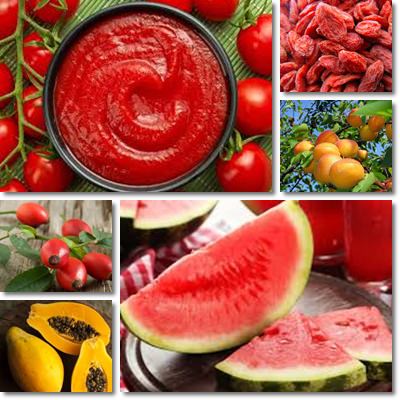The name derives from the Latin scientific name of tomatoes (Solanum lycopersicum) and refers to a natural red pigment found in numerous fruits and vegetables. The scientific community has classified lycopene as a carotenoid, which is a natural red pigment highly beneficial for human health because of its impressive antioxidant effects. Moreover, research suggests lycopene boasts anticancer properties and can help lower high blood pressure naturally and prevent the oxidation of blood cholesterol, contributing to cardiovascular health.
Tomatoes, watermelons, red bell peppers, pink grapefruit, guava, goji, papaya, rose hip berries and red carrots are all rich sources of lycopene. Consuming them on a regular basis, preferably when they are in season and grown naturally, without pesticides, can supply the body with wonderfully healthy nutrients, lycopene included and provide benefits for the cardiovascular system, eyesight as well as antioxidant protection against oxidative stress caused by free radical damage and chronic illness.

Why is it important to get enough lycopene?
Why should we include lycopene-rich foods in our diet? First of all, lycopene is a powerful natural antioxidant capable of counteracting the harmful effects of reactive oxygen molecules called free radicals. The latter are responsible for oxidative stress which engenders a myriad of health problems from premature aging to cardiovascular disease and cancer.
A high intake of antioxidants from food sources is believed to prevent free radical damage buildup that can potentially damage DNA and interfere with normal cell function. One example of what may happen when such damage builds up is cells go haywire and keep on dividing even when there is no need for new cells, forming tumors.
Numerous scientific studies suggest that lycopene can efficiently inhibit tumor growth and significantly reduce the risk of developing oxidative stress-related illnesses such as cancer, cardiovascular disease and macular degeneration, or loss of central vision as a result of old age.

In addition to this, a high intake of lycopene appears to have beneficial effects on both systolic and diastolic blood pressure, lowering high blood pressure by 9 and 7 mmHg (millimeters of mercury) in grade I hypertensive individuals. Grade I hypertension (or prehypertension) is the first stage of high blood pressure and refers to blood pressure that is higher than 120/80 (or 130/90) mmHg and lower than 159/99 mmHg (Oxford Journals, P-333: Effect of tomato’s lycopene on blood pressure, serum lipoproteins, plasma homocysteine and oxidative stress markers in grade I hypertensive patients).
Preliminary studies suggest that regular consumption of lycopene-rich foods can also offer protection against heart disease by preventing the oxidation of low-density lypoproteins (LDL cholesterol), which may damage cell membranes as well as result in the formation of reactive oxygen molecules (free radicals) with mutagenic and carcinogenic effects. However, research is ongoing and it may take some time until we are given clear guidelines as to how dietary lycopene can protect us from cardiovascular damage.
Is lycopene stored in the body?
Although it is not considered fundamental for human health, lycopene can be found almost anywhere in our body. After consuming foods containing it, the carotenoid is absorbed at the intestinal level to be used for various processes. Lycopene is stored in the liver, from where it enters the bloodstream.
Other areas of the body where it is deposited include organs such as the prostate, the colon and the adrenal glands situated above the kidneys. Small amounts can be found in the ovaries and skin as well.
Considering its wide distribution and storage in different areas of the body, it can be assumed the human body needs lycopene for performing various functions and ensuring good health.
Best lycopene food sources
A healthy and varied diet should supply the body with sufficient lycopene. The best dietary sources include tomatoes, watermelons, goji berries, gac fruit, papaya, rose hip, red carrots, guava and the deliciously sweet red bell peppers.
Also see benefits of gac fruit.
Lycopene in tomatoes
Tomato sauce is a rich source of lycopene as well. However, the pulp and skin contain more lycopene than the juice so, when cooking with tomatoes, it is best to crush them and use them whole in order to get the best of their nutrient content. For this reason, canned tomatoes and tomato paste are a better choice than tomato juice.
And here is a tip: the riper the tomato, the more lycopene it contains. Although it is a red pigment, lycopene can be found in very small amounts in parsley, asparagus and basil as well. Nonetheless, red fruits and vegetables such as the ones mentioned above are the best sources. All in all, lycopene is a natural red pigment in fruits and vegetables and holds impressive health benefits.
